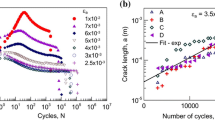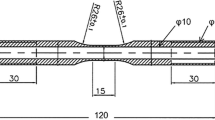Abstract
The damage mechanisms influencing the axial strain-controlled low-cycle fatigue (LCF) behavior of alloy 800H at 850 °C have been evaluated under conditions of equal tension/compression ramp rates (fast-fast (F-F): 4 × 10−3 s−1 and slow-slow (S-S): 4 × 10−5 s−1) and asymmetrical ramp rates (fast-slow (F-S): 4 × 10−3 s−1 / 4 × 10−5 s−1 and slow-fast (S-F): 4 × 10−5 / 4 × 10−3 s−1) in tension and compression. The fatigue life, cyclic stress response, and fracture modes were significantly influenced by the waveform shape. The fatigue lives displayed by different loading conditions were in the following order: F-F > S-S > F-S > S-F. The fracture mode was dictated by the ramp rate adopted in the tensile direction. The fast ramp rate in the tensile direction led to the occurrence of transgranular crack initiation and propagation, whereas the slow ramp rate caused intergranular initiation and propagation. The time-dependent processes and their synergistic interactions, which were at the basis of observed changes in cyclic stress response and fatigue life, were identified. Oxidation, creep damage, dynamic strain aging, massive carbide precipitation, time-dependent creep deformation, and deformation ratcheting were among the several factors influencing cyclic life. Irrespective of the loading condition, the largest effect on life was exerted by oxidation processes. Deformation ratcheting had its greatest influence on life under asymmetrical loading conditions. Creep damage accumulated the greatest amount during the slow tensile ramp under S-F conditions.
Similar content being viewed by others
References
J. Bressers, U. Schusser, W. Weise, R. De Cat, and E. Fenske: Cost 501 Final Report, EUR 11693 EN (1988), Commission of the European Communities, 1988, pp. 1-56.
K. Bhanu Sankara Rao, H. Schiffers, H. Schuster, and H. Nickel:Metall. Mater. Trans. A, 1996, vol. 27A, pp. 255–68.
J. Bressers, U. Schusser, and B. Ilschener: inLow Cycle Fatigue and Elasto-Plastic Behavior of Materials, K.T. Rie, ed., Elsevier Applied Science, London, 1987, pp. 365–70.
J. Barbehon, A. Rahmel, and M. Schutze: inLow Cycle Fatigue and Elasto-Plastic Behavior of Materials, K.T. Rie, ed., Elsevier Applied Science, London, 1987, pp. 371–77.
B.A. Lerch, B. Kempf, D. Steiner, and V. Gerold:Proc. 7th Int. Conf. on the Strength of Metals and Alloys, Montreal, H.J. McQueen, J.-P. Bailon, J.I. Dixon, J.J. Jonas, and M.G. Akbon, ed. Pergamon Press, Oxford, 1986, pp. 1299–1304.
B. Kempf, K. Bothe, and V. Gerold: Paper presented at6th Eur. Conf. on Fracture, Amsterdam, 1986.
K. Bothe, B. Kempf, and V. Gerold: inHigh Temperature Alloys for Gas Turbines and other Applications, W. Betz, R. Brunetaud, D. Coutsouradis, H. Fischmeister, T.B. Gibbons, I. Kvernes, Y. Lindblom, J.B. Marriott, and D.B. Meadowcroft, eds., D. Reidel Publishing Company, Dordrecht, 1986, pp. 1517–26.
B. Kempf, K. Bothe, and V. Gerold:Z. Metallkd., 1986, vol. 77, pp. 576–81.
J. Bressers, W. Weise, and T. Hollstein: inLow Cycle Fatigue and Elasto-Plastic Behavior of Materials, K.T. Rie, ed., Elsevier Applied Science, London, 1987, pp. 655–60.
K.Y. Hour and J.F. Stubbins:Metall. Trans. A, 1989, vol. 20A, pp. 1727–34.
B. Kempf, K. Bothe, and V. Gerold: inLow Cycle Fatigue and Elasto- Plastic Behavior of Materials, K.T. Rie, ed., Elsevier Applied Science, London, 1987, pp. 271–76.
P. Agatonovic and N. Taylor: inProc. 6th Int. Conf. on Mechanical Behavior of Materials—VI, Kyoto, Japan, M. Jono and T. Inoue, eds., Pergamon Press, Oxford, 1992, pp. 303–10.
G.R. Haiford, M.H. Hirschberg, and S.S. Manson:Temperature Effect on the Strainrange Partitioning Approach for Creep-Fatigue Analysis, ASTM STP 520, ASTM, Philadelphia, PA, 1973, pp. 658–69.
S.S. Manson:The Challenge to Unify Treatment of High Temperature Fatigue—A Partisan Approach Based on Strain Range Partitioning, ASTM STP 520, ASTM, Philadelphia, PA, 1973, pp. 744–82.
S.S. Manson, G.R. Halford, and A.J. Nachtigall:Advances in Design for Elevated Temperature Environment, ASME, Fairfield, NJ, 1975, pp. 17–28.
H.P. Meurer, G.H.K. Gnirss, W. Mergler, G. Raule, H. Schuster, and G. Ulrich:Nucl. Technol, 1984, vol. 66, pp. 315–23.
L.F. Coffin, Jr.:Metall. Trans., 1974, vol. 5, pp. 1053–64.
K. Bhanu Sankara Rao, M. Valsan, R. Sandhya, S.L. Mannan, and P. Rodriguez:Trans. Ind. Inst. Met., 1991, vol. 44, pp. 255–71.
K. Bhanu Sankara Rao, M. Valsan, R. Sandhya, S.L. Mannan, and P. Rodriguez:High Temp. Mater. Processes, 1986, vol. 7, pp. 171–78.
M. Valsan, K. Bhanu Sankara Rao, D.H. Shastry, and S.L. Mannan:Metall. Mater. Trans. A, 1994, vol. 25A, pp. 159–71.
J. Bressers, L. Remy, and W. Hoffelner:Proc. Conf. High Temperature Alloys for Gas Turbines and Other Applications, Leigh, Oct. 6–9, 1986, W. Betz, R. Brunetaud, D. Coutsouradis, H. Fischmeister, T.B. Gibbons, I. Kvernes, Y. Lindblom, J.B. Marriott, and D.B. Meadowcroft, eds., D. Riedel Publishing Company, Dordrecht, 1986, p. 441.
D. Sidey and L.F. Coffin, Jr.:Low Cycle Fatigue Damage Mechanisms at High Temperature, ASTM STP 675, ASTM, Philadelphia, PA, 1979, pp. 528–68.
B.K. Min and R. Raj:A Mechanism of Intergranular Fracture during High Temperature Fatigue, ASTM STP 675, ASTM, Philadelphia, PA, 1979, pp. 569–91.
S.S. Manson and G.R. Halford:Isr. J. Technol., 1993, vol. 21, pp. 29–53.
G.R. Halford and A.J. Nachtigall:J. Aircraft, 1980, vol. 17, pp. 598–604.
D.C. Lord and L.F. Coffin, Jr.:Metall Trans., 1973, vol. 4, pp. 1647–53.
M. Okazami, I. Hotari, and T. Koizumi:Metall. Trans. A., 1984, vol. 15A, pp. 1731–39.
Author information
Authors and Affiliations
Additional information
Formerly USA National Research Council Associate, NASA-Lewis Research Center
This article is based on a presentation made at the “High Temperature Fracture Mechanisms in Advanced Materials” symposium as a part of the 1994 Fall meeting of T.S., October 2-6, 1994, in Rosemont, Illinois, under the auspices of the ASM/SMD Flow and Fracture Committee.
Rights and permissions
About this article
Cite this article
Rao, K.B.S., Schuster, H. & Halford, G.R. Mechanisms of high-temperature fatigue failure in alloy 800H. Metall Mater Trans A 27, 851–861 (1996). https://doi.org/10.1007/BF02649752
Issue Date:
DOI: https://doi.org/10.1007/BF02649752




